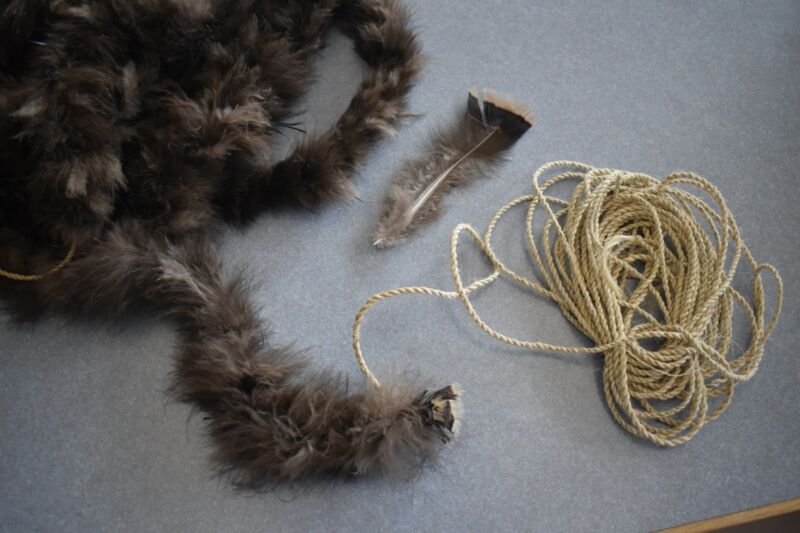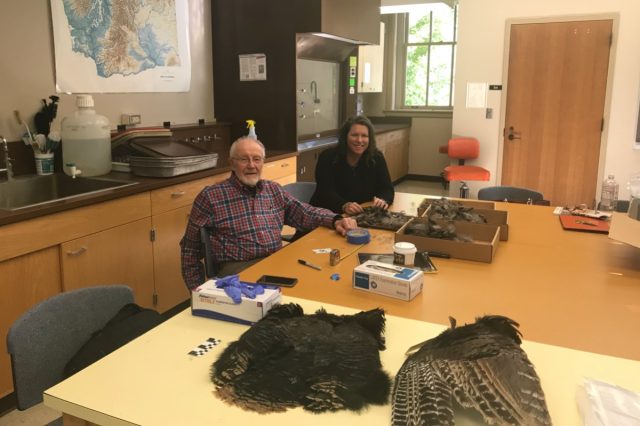Birds of a feather —
You’d need the feathers from 4 to 10 turkeys, according to WSU anthropologists.
Jennifer Ouellette
–

Enlarge / A segment of fiber cord that has been wrapped with turkey feathers, along with a single downy feather.
Indigenous Pueblo populations in the American Southwest—ancestors of today’s Hopi, Zuni, and Rio Grande Pueblo tribes—typically wove blankets, cloaks, and funeral wrappings out of animal hides, furs, and turkey feathers. Anthropologists at Washington State University (WSU) have examined one such ancient turkey-feather blanket and determined it took thousands of those feathers, wrapped around nearly 200 yards of yucca fiber, to make it, according to a new paper published in the Journal of Archaeological Science: Reports.
“Blankets or robes made with turkey feathers as the insulating medium were widely used by Ancestral Pueblo people in what is now the Upland Southwest, but little is known about how they were made because so few such textiles have survived due to their perishable nature,” said co-author Bill Lipe, emeritus professor of anthropology at WSU. “The goal of this study was to shed new light on the production of turkey feather blankets and explore the economic and cultural aspects of raising turkeys to supply the feathers.”
For their study, Lipe and his WSU colleague and co-author, Shannon Tushingham, studied a blanket framework on display at the Edge of the Cedars State Park Museum in Blanding, Utah. Although insects had devoured the original feather vanes and barbs, the shafts were still visible, wrapped around yucca fiber cords. They were also able to look at a second, smaller blanket that still had most of its feathers intact. Both blankets roughly date to the early 1200s CE.
According to the authors, such blankets were likely made from the body feathers that cover the breast and back of turkeys. Such feathers have a visible “after feather,” as well as a downy portion—a key factor in how feathers keep turkeys and people warm. Both the distal tips and the quills at the base are typically overwrapped during the weaving process, with the downy portions exposed. They are held together by rows of nonwrapped yucca fiber cords, which comprise the weave of the blanket. They measured the length of the cordage used to make the warps and wefts, the two components in weaving used to turn thread or yarn into fabric (lengthwise yarns are called warp; crosswise yarns are called weft).
No rush
The blanket might have been created all at once, but the authors surmise that additional lengths of cordage and feather batches were probably added over time. However, they do think the feathers were added to the full warp cord before the final blanket took shape, “before the cord was repeatedly doubled back on itself to form the individual warp segments,” they wrote.
They also counted the number of individual feather shafts on several segments of the warp cords. However, it wasn’t possible to examine the quills or ends of the feathers, or the distal tips, since they had been overwrapped by adjacent feathers. Ultimately, the researchers estimated that approximately 11,500 turkey feathers would have been needed to make the blanket. “This estimate would of course change if different lengths of feather were used,” they wrote, depending on the feathers that were available and on the personal preferences of whoever wove the blanket.

Enlarge / Bill Lipe and Shannon Tushingham collect feathers from a wild-turkey pelt in Tushingham’s lab at Washington State University in Pullman, Washington.
Washington State University
Next, the researchers obtained the pelts of two adult male wild turkeys from Idaho hide and fur dealers, the better to estimate how many adult turkeys would be needed to provide 11,500 or so feathers. They concluded such pelts would yield a little over 2,700 feathers from an adult male turkey. From that, they extrapolated that a blanket-maker would need to collect feathers from 4.26 adult males. But since only 1,200 feathers per bird were in the preferred size range, it may have taken as many as 9.6 adult birds to collect enough feathers for the blanket. The good news: “Once a blanket was made, it likely would have lasted for a number of years,” the authors wrote.
Turkey feathers likely began to replace strips of rabbit skin for blankets sometime during the first two centuries CE. “As ancestral Pueblo farming populations flourished, many thousands of feather blankets would likely have been in circulation at any one time,” said Tushingham. “It is likely that every member of an ancestral Pueblo community, from infants to adults, possessed one.”
As for how the feathers were collected, Lipe and Tushingham cited three possibilities: the birds were killed and their feathers harvested; feathers were collected during the birds’ natural molting season; or people selectively plucked mature feathers from living turkeys. Turkeys didn’t become a major food source in this region until between 1100 and 1200 CE, and even then, they were typically killed before they were a year old—too soon to harvest mature feathers. Furthermore, “Killing turkeys for their feathers is a wasteful strategy, because it removes the possibility of harvesting feathers as a sustainable food source,” the authors wrote.
“Reverence for turkeys”
As for collecting feathers during the natural molting season, this typically occurs gradually over weeks or months. If the turkeys were roaming freely, it would be difficult to collect the best feathers, and if they were penned, the feathers would be trampled in the ground—no doubt also littered with turkey droppings. (The authors note that modern wild turkeys produce 2.5 pounds of “fresh manure” per bird each week.) Thus, the authors conclude that the most likely practice was to selectively pluck feathers from live birds, which can be done quite easily once feathers have matured.
“When the blanket we analyzed for our study was made, we think in the early 1200s CE, the birds that supplied the feathers were likely being treated as individuals important to the household and would have been buried complete,” Lipe said. “This reverence for turkeys and their feathers is still evident today in Pueblo dances and rituals. They are right up there with eagle feathers as being symbolically and culturally important.”
“Turkeys were one of the very few domesticated animals in North America until Europeans arrived in the 1500s and 1600s,” Tushingham added. “They had and continue to have a very culturally significant role in the lives of Pueblo people, and our hope is this research helps shed light on this important relationship.”
DOI: Journal of Archaeological Science: Reports, 2020. 10.1016/j.jasrep.2020.102604 (About DOIs).

